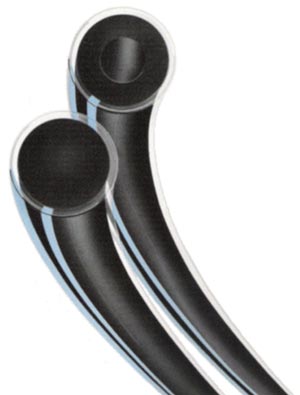Noted for their broad chemical resistance and performance in harsh environments, encapsulated o’rings are toroidal seals of a two piece design featuring a hollow transparent plastic outer casing with an elastomer (rubber) core.
Noted for their broad chemical resistance and performance in harsh environments, encapsulated o’rings are toroidal seals of a two piece design featuring a hollow transparent plastic outer casing with an elastomer (rubber) core which combines the low friction and physiologically neutral properties of solid virgin PTFE (aka Teflon®) with some mechanical properties of rubber o’rings.
Virgin PTFE o’rings being a hard plastic, do not squash and deflect like rubber does which can make installation difficult and requires high clamping forces to achieve the same sealing efficiency as a rubber o’ring. An encapsulated o’ring features an extruded thermoplastic tube that is filled with an elastomeric core and joined. This allows an o’ring to be made with the friction coefficient and non-reactivity of virgin PTFE, with some elastomeric properties of a rubber o’ring such as deflection with limited compression set.

FEP: Commonly, the outer casing is a tube made of fluorinated ethylene propylene (FEP), a copolymer of hexafluoropropylene and tetrafluoroethylene that possess similar properties to virgin PTFE (Teflon). It differs from PTFE in that the resin is melt-processible using conventional injection moulding and screw extrusion techniques.
Operating Temperature: -270°C to 204°C (depending on core material)
PFA: Less common than FEP type, perfluoroalkoxy alkane resin (PFA) is a copolymer of tetrafluoroethylene and perfluoroethers. PFA resin is also a clear thermo-moulded plastic with similar properties to PTFE. Encapsulated PFA o’rings have a higher temperature rating and better resistance to mechanical stresses at elevated temperatures where FEP can fail.
Operating Temperature: Up to 260°C (depending on core material)
The rubber core of an encapsulated o’ring is usually made out of either fluorocarbon (FKM, aka Viton®), silicone (VMQ) or ethylene propylene diene monomer (EPDM). The core is usually solid but can be ordered with a hollow core for easier deflection.
For cryogenic service; a stainless steel spring core is utilised where extreme low temperatures will cause a rubber core to harden and lose its elasticity.
Please note: Even though the elastomer core of an encapsulated o’ring is completely enclosed by the outer casing, some chemicals can permeate the casing and reach the core. Therefore chemical compatibility of the sealing medium should be considered when selecting core material.
Sealing Australia stocks encapsulated o’rings in the British Standard (BS1086) imperial range, but sizing is not limited to BS imperial. Because encaps are made from an extrusion, almost any diameter and cross section can be made with less fuss than a fully moulded o’ring. Please contact us for more info or see our o’ring sizing page for a listing of BS imperial sizes.

Sealing Australia is proud to be the Australian and New Zealand agent for Sealmor Industries, a leading manufacturer of high quality encapsulated o’rings sold under the popular TEFLEX and TEMFLEX brand names. With over 30 years experience in the field, their professional R&D and engineering team have produced encapsulated o’rings of unparalleled detail and quality. Sealing Australia can offer competitive prices on Sealmor’s quality products.
HOURS OF OPERATION • AEST Monday to Thursday 8.30 am – 5.30 pm